I-Joists Versus Trusses
July 22, 2024
I-joists offer several advantages over dimension lumber, including greater strength, longer spans, little to no twisting or bowing, and more consistency from piece to piece. But how do they compare to open-web (metal-plated wood) floor trusses? While floor trusses are popular among some builders as a faster alternative to traditional floor framing, designing floor systems with I-joists offer a number of advantages. Here are a few things to consider:
More Versatility
Trusses are designed specifically for each job, so they require much more pre-planning and can’t be modified; they’re not field trimmable or adjustable in the field, so any mistakes or even small changes in the footprint and framing of the house cannot be accommodated. I-joists are interchangeable and come in longer lengths, so they can be used for any job and trimmed in the field. This versatility also is helpful for spanning interior bearing walls. Floor trusses are designed specifically for all bearing supports. If interior walls are moved mid-build, those trusses can no longer be used. I-joists are much more accommodating of field changes.
The Benefits of Engineered Wood
One of the biggest selling factors of an engineered wood product like I-joists is the long-term performance. Dimension lumber has a higher moisture content, which makes it prone to shrinkage as it loses moisture over time, leading to nail pops and squeaks in the flooring system. Because floor trusses are made with dimension lumber, they may be prone to the typical shrinkage that can cause squeaks down the road.

Flexibility in Hole Placement
Because floor trusses are naturally open, they’re some builders’ go-to as an easy way to run piping and ductwork. However, the openings for larger mechanical lines are in a typical single and fixed location and must be designed with everything precisely thought out and measured to avoid obstacles from cross members. With I-joists, you can cut holes on site following simple hole location charts or easy-to-use software; and in some cases, the dealer can pre-cut holes prior to delivery at the job site.
Pricing Stability
I-joists are proprietary and made with engineered wood, so their price tends to be more consistent. The volatility of lumber costs makes trusses more vulnerable to large price fluctuations.
No Engineer Required
Each individual truss design requires an engineer’s seal for every project. Because I-joists have constant design values published in ICC-ES® building code evaluation reports, engineer seals are typically not required.
Click here to see what makes I-Joists so popular.